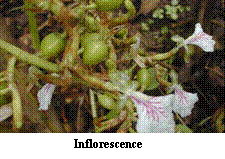|
Origin
Cardamom is a native of Western Ghats in South India. India had a virtual monopoly
of cardamom till recently. But now it is being cultivated in Guatemala, Sri Lanka,
Thailand, Laos, Vietnam, Costa Rica, El Salvador and Tanzania. Cardamom cultivation
in India is confined to three States, viz. Kerala, Karnataka and Tamil Nadu.

Cardamom was an article of Greek trade during the fourth century BC. It is doubtful
whether the Greeks and Romans had the true cardamoms i.e., Elettaria.
Marcopolo does not mention cardamom in his travel documents but the Portuguese
traveller Parbosa in 1514 described its trade with the Malabar Coast. The earliest
record of cardamom in India is in an Ayurvedic medical treatise compiled in BC 1000.
Popularly known as "Queen of spices", small cardamom of commerce is an
important and popular flavouring material and spice. The useful part is the dried
mature fruit. It is usually referred to as capsule. Cardamom is used for flavouring
curries, cakes, and bread and for other culinary purposes. It is also used as masticatory
and for flavouring coffee and confectionery. An essential oil is obtained by steam
distillation of the seeds, which is used for flavouring processed foods and liquors,
in perfumery and beverages. The pleasant aroma and the characteristic warm, slightly
pungent taste are due to numerous essential oil components present in the seeds.
Characteristics

|
Cardamom is a perennial bushy herb. The tuberous underground rhizome is its real
stem and the aerial shoot is a pseudostem and formed by the encircling leaf sheaths.
The leaves are long, alternate and lanceolate in shape. Flowers are borne on panicles
and they emerge directly from the underground stem on long floral stalks. They are
hermaphrodite and zygomorphic. The fruits are tri-locular, ovoid or oblong, greenish-brown
capsules containing about 15-20 seeds attached to axil placenta. Light reddish or
dark reddish brown seeds are irregularly three-sided, transversely wrinkled or furrowed
and are covered by a membranous aril.
|
Cardamom essential oil has traditionally been used as a tonic to the digestive system,
as well as a component of many sensual aphrodisiac blends . Cardamom
oil may relieve spasm, making it possibly beneficial for colitis, irritable bowel
syndrome, indigestion and cramps. Cardamom oil may be of benefit where the digestive
system is affected by nervous tension. In addition, cardamom oil can relieve nausea
and may be useful for morning sickness in pregnancy for some mothers-to-be.
Cardamom is ground and mixed with ground coffee and served as “KAWA”,
a favourite drink among the Arabs. In America and Europe where the cardamom is used
mainly in the grinding or distilling industry, the colour is of no importance.
The cardamom oil is a precious ingredient in food preparations, perfumery, health
foods, medicine and beverages. A good portion is consumed for chewing or as a masticatory
item. In medicine, it is used as powerful aromatic, stimulant, carminative, stomachic
and diuretic, but rarely used alone. It also checks nausea and vomiting, helps in
combating digestive ailments. Herbal lures on this spice suggest it can be used
to freshen your breath and support smooth digestion.
|